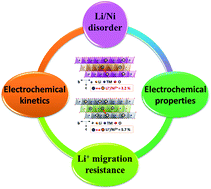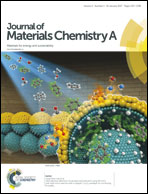New insight into Li/Ni disorder in layered cathode materials for lithium ion batteries: a joint study of neutron diffraction, electrochemical kinetic analysis and first-principles calculations†
Abstract
Although layered cathode materials LiNixMnyCo1−x−yO2 have attracted much attention due to their number of advantages, the issue of Li/Ni disorder seriously restricts their electrochemical properties. It is very important and pivotal for the better optimization of layered cathode materials to clearly explain the detailed relationships among the Li/Ni disorder, Li+ migration resistance, electrochemical kinetics and electrochemical properties. Here we focus on the LiNixMnyCo1−x−yO2 cathode material and report relationships among the crystal structures, Li+ migration resistance, electrochemical kinetics and electrochemical properties by combining neutron diffraction techniques, electrochemical kinetic analysis techniques and first-principles calculation methods. The results suggest that more Li+/Ni2+ ion exchange will shrink the inter-slab space thickness, causing a higher Li+ ion migration barrier and inferior electrochemical kinetics, all of which should be responsible for the limited electrochemical properties.


 Please wait while we load your content...
Please wait while we load your content...